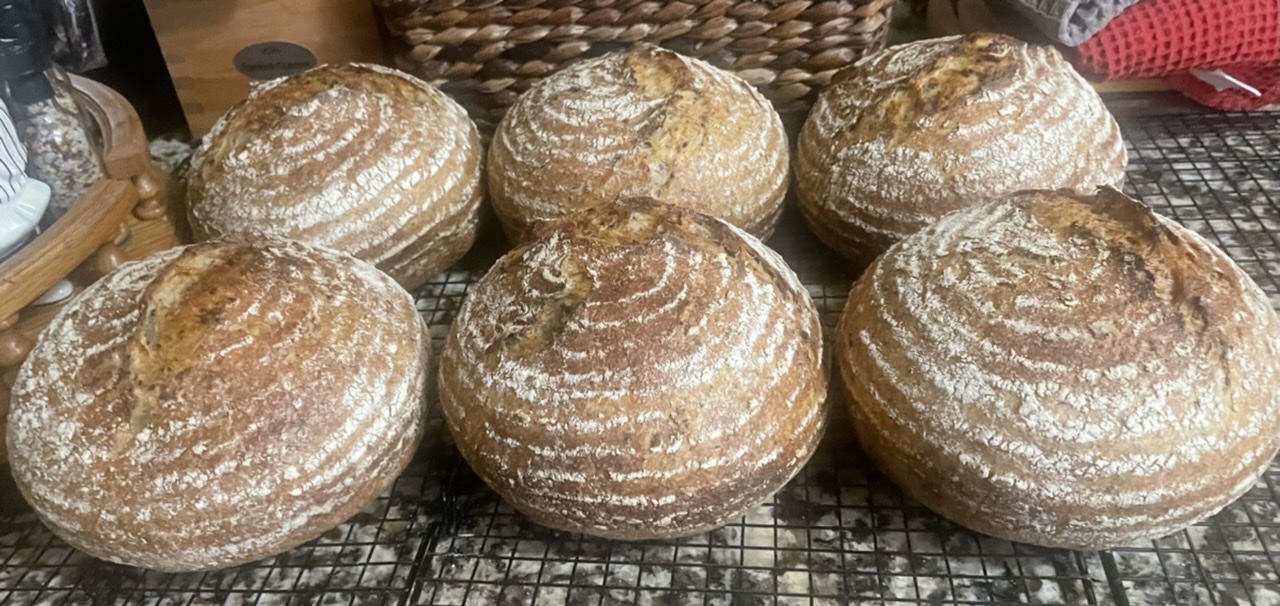
Heart Healthy Sourdough


Recipe
Makes 3 loaves
Porridge
150 g rolled oats
300 g water
Dough
700 g Strong Bakers Unbleached flour
200 g freshly milled whole grain Spelt flour (200 g Spelt berries)
100 g freshly milled whole grain Kamut flour (100 g Kamut berries)
50 g freshly ground flax seeds
25 g black sesame seeds
700 g water + 25 g
22 g salt
30 g yogurt
50 g olive oil
250 g levain (procedure in recipe)
Extra wholegrain flour of your choice for feeding the levain
The night before:
- Mill the grains and place in a tub. Add the unbleached flour to the tub as well. Cover and set aside.
- Take 10 g of refrigerated starter and feed it 20 g of water and 20 g of wholegrain flour. Let that rise at cool room temperature for the night.
Dough Making day:
1. Early in the morning, feed the levain 100 g of filtered water and 50 g of strong baker’s flour and 50 g wholegrain flour. Let rise until doubled (About 5 hours, mine was ready in 4 and a half).
2. About two hours before the levain is ready, put 700 g of water in a stand mixer’s bowl and add the flours from the tub. Mix on the lowest speed until all the flour has been hydrated. This takes a couple of minutes. Autolyse for a couple of hours at room temperature.
3. Make the porridge: Add the water to the rolled oats and cook on medium heat until the liquid is absorbed and porridge is very thick and creamy.
4. Once the autolyse is done and the levain has doubled, add the salt, the yogurt, the porridge, the oil, and the levain to the bowl. Add the extra water if needed. Mine needed it. Mix on the lowest speed for a minute to integrate everything, then mix on the next speed for 9 minutes.
5. Remove the dough from the mixing bowl and place in a lightly oiled covered tub. Let rest 45 minutes in a warm spot (oven with light on).
6. Do 2 sets of coil folds at 45 minute intervals and then 1 more set after 30 minutes. Let rise about 30%.
7. Tip the dough out on a bare counter, sprinkle the top with flour and divide into portions of ~860g. Round out the portions into rounds with a dough scraper and let rest 30 minutes on the counter.
8. Do a final shape by flipping the rounds over on a lightly floured counter. Gently stretch the dough out into a circle. Pull and fold the third of the dough closest to you over the middle. Pull the right side and fold over the middle and do the same to the left. Fold the top end to the center patting out any cavities. Finally stretch the two top corners and cross over each other in the middle. Roll the bottom of the dough away from you until the seam is underneath the dough. Cup your hands around the dough and pull towards you, doing this on all sides of the dough to round it off. Finally spin the dough to make a nice tight boule.
9. Sprinkle a mix of rice flour and all purpose flour in the bannetons. Place the dough seam side down in the bannetons. Let rest for a few minutes on the counter and then put to bed in a cold (38F) fridge overnight.
Baking Day
1. The next morning, about 11-12 hours later, heat the oven to 475F with the Dutch ovens inside for 45 minutes to an hour. Turn out the dough seam side up onto a cornmeal sprinkled counter. Place rounds of parchment paper in the bottom of the pots, and carefully but quickly place the dough seam side up inside.
2. Cover the pots and bake the loaves at 450 F for 25 minutes, remove the lids, and bake for another 20 minutes at 425 F. Internal temperature should be 205 F or more.


Comments
One of these days, I'm going to have to make a trip to the other side of the lake and pick up one of these loaves. ;-)
Look great as always!
Very cool ingredients. Does that porridge make for a creamy final crumb? I tried a yudane (20% of flour, 1:1 fresh milled wheat plus boiling water sitting overnight) and it made for a creamy texture, airy crumb, and yet crispy crust in the final baguette. Seems like a great way of making whole grain breads not only work well but excel.
Usually makes for a creamy crumb. Your idea of a yudane is new to me. I’ve heard of a Tangzhong but have never tried it.
Yes a Yudane is Japanese rather than Chinese Tangzhong Danni. Yudane are great if you’re only using water since you can just boil the water and pour it on the flour. If I’m using milk then I’ll use a Tangzhong since I wouldn’t put milk in my kettle.
Beautiful bakes Danni.
I'm thinking you could used scalded milk for a yudane. Just bring a pot of milk up to the point it is steaming with tiny bubbles around the perimeter. Scalded milk is supposed to be better than milk for other kinds of baking for rising... now I am curious!
Go ahead and try it!